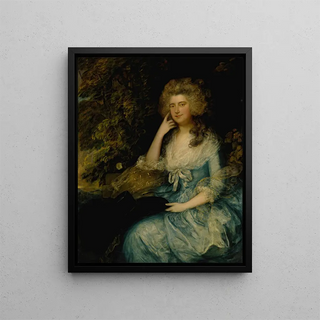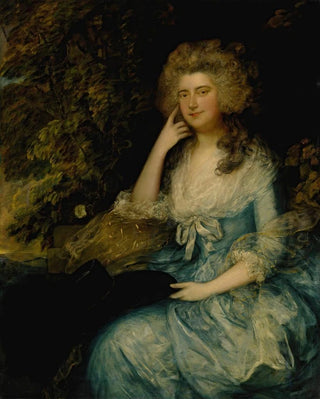Art print | Mme William Tennant and Mary Wylde sitting in a landscape - Thomas Gainsborough


View from behind

Frame (optional)
In the world of art, certain works transcend the simple frame of painting to become witnesses of an era, reflections of society. The art print of "Mme William Tennant and Mary Wylde seated in a landscape" by Thomas Gainsborough perfectly illustrates this idea. This painting, depicting two elegant women in a bucolic landscape, evokes not only visual beauty but also a sense of serenity and grace. Contemplating this piece, the viewer is transported to a world where nature and fashion coexist harmoniously. The refined details and subtle use of light invite a complete immersion into Gainsborough's universe, where each brushstroke tells a story.
Style and uniqueness of the work
Gainsborough's style is often characterized by his ability to capture natural beauty and the elegance of his subjects. In "Mme William Tennant and Mary Wylde seated in a landscape," the female figures are portrayed with a delicacy that demonstrates the artist's skill in rendering the texture of clothing and the luminosity of faces. The flowing dresses and natural poses of the two women, seated in a verdant setting, are accentuated by a palette of soft and harmonious colors. The choice of landscape, with its majestic trees and clear sky, creates a striking contrast with the sophistication of the characters. This work stands out for its ability to combine portraiture with genre scene, a duality that allows exploring both the individuality of the subjects and their relationship with the environment.
The artist and his influence
Thomas Gainsborough, an iconic figure of the 18th century, established himself as one of the masters of English painting. His innovative approach to portrait and landscape influenced many contemporary and later artists. Gainsborough was not content with merely reproducing reality; he sought to capture the very essence of his subjects, to reveal their character through a subtle interaction with their environment. His technique, blending finesse and expressiveness, paved the way for a new way of viewing portraiture, where the individual is in symbiosis with nature. By painting

Matte finish

View from behind

Frame (optional)
In the world of art, certain works transcend the simple frame of painting to become witnesses of an era, reflections of society. The art print of "Mme William Tennant and Mary Wylde seated in a landscape" by Thomas Gainsborough perfectly illustrates this idea. This painting, depicting two elegant women in a bucolic landscape, evokes not only visual beauty but also a sense of serenity and grace. Contemplating this piece, the viewer is transported to a world where nature and fashion coexist harmoniously. The refined details and subtle use of light invite a complete immersion into Gainsborough's universe, where each brushstroke tells a story.
Style and uniqueness of the work
Gainsborough's style is often characterized by his ability to capture natural beauty and the elegance of his subjects. In "Mme William Tennant and Mary Wylde seated in a landscape," the female figures are portrayed with a delicacy that demonstrates the artist's skill in rendering the texture of clothing and the luminosity of faces. The flowing dresses and natural poses of the two women, seated in a verdant setting, are accentuated by a palette of soft and harmonious colors. The choice of landscape, with its majestic trees and clear sky, creates a striking contrast with the sophistication of the characters. This work stands out for its ability to combine portraiture with genre scene, a duality that allows exploring both the individuality of the subjects and their relationship with the environment.
The artist and his influence
Thomas Gainsborough, an iconic figure of the 18th century, established himself as one of the masters of English painting. His innovative approach to portrait and landscape influenced many contemporary and later artists. Gainsborough was not content with merely reproducing reality; he sought to capture the very essence of his subjects, to reveal their character through a subtle interaction with their environment. His technique, blending finesse and expressiveness, paved the way for a new way of viewing portraiture, where the individual is in symbiosis with nature. By painting






